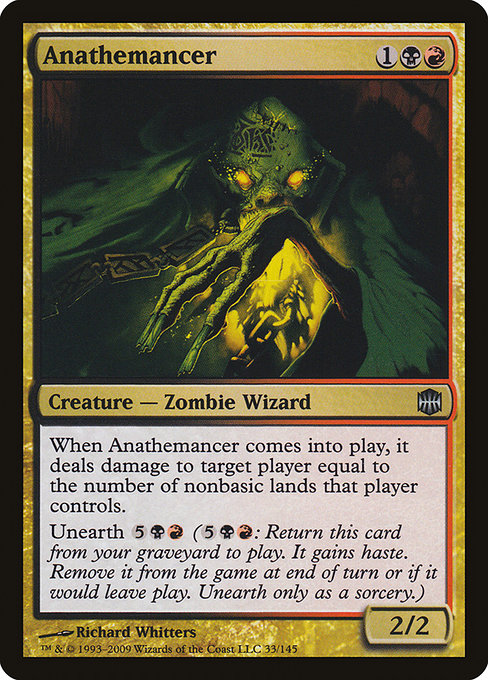
Image courtesy of Scryfall.com
Unconventional Creativity: Anathemancer and the Silver Border Mindset
Magic: The Gathering isn't solely about raw efficiency or the tightest curve. It’s also about shaping games through constraints, misdirections, and a spark of audacity. The idea of “silver-border” play—playful, puzzle-like interactions that bend expectations—lives on in the community even when the cards themselves live inside polished black borders. Anathemancer, a 2009 gem from Alara Reborn, isn’t a silver-border card, yet its design aesthetic taps into that same spirit: it rewards you for reading the battlefield creatively and punishing your opponent for overclocking their mana base. 🧙♂️🔥
Look at Anathemancer’s core features. For a modest three-mana investment—{1}{B}{R}—the card arrives as a 2/2 Zombie Wizard with a potent ETB trigger: when it enters, it deals damage to a target player equal to the number of nonbasic lands that player controls. That’s not just a damage pinata; it’s a read on the table. The more nonbasics your foe has, the bigger the burn. This is where the silver-border mindset shines: a single card nudges you to design around the opponent’s mana engine, not just your own. The design leans into timing, information, and the psychology of play—elements cherished at casual tables and cherished even more in formats where knowledge of a deck’s nonbasics can tilt a game. ⚔️
Even more interesting is Anathemancer’s ability to be rekindled from the graveyard via Unearth for {5}{B}{R}. Unearth is a classic that lets you snap a fallen threat back onto the battlefield, haste granted, only to exile it at the next end step or if it would leave the battlefield. That means you can flash back Anathemancer to apply late-game pressure, or keep the threat looping as a way to keep a pressure valve open against midrange and control strategies. The mechanic’s inclusivity—triggering recursion from the graveyard—creates a choreography between tempo, resource denial, and surprise value. It’s the kind of design that invites a host of offbeat, creative plays at kitchen tables and in more expansive B/R shell experiments. 🧩
“The best silver-border-inspired ideas didn’t always land in the right color pie, but they taught us to look at rules differently—and that’s a big part of how creative MTG communities grow.”
In practice, Anathemancer becomes a touchstone for conversations about how to reward ingenuity in deckbuilding. Consider the dynamic of nonbasic lands: if your opponent leans into kingdoms of fetches, shocklands, utility lands, and signets, Anathemancer’s ETB swing can be a meaningful tempo edge. The card encourages you to consider not just what you want to do on your own turn, but how your opponent’s mana configuration affects the board state. It’s a neat reminder that the most memorable plays often come from reading a table and planning a few steps ahead, rather than simply resolving the biggest spell on turn three. 🧠🎲
Another layer of creativity comes from the graveyard—Unearth’s presence means Anathemancer isn’t a one-shot puzzle piece. You can weave a circuit where you reanimate it after a sweep or removal, a little dance that feels both retro and modern. The synergy invites players to experiment with reanimation, tempo, and even political play at the table, as you decide when to press advantage and when to reset the board with a stubborn 2/2 that refuses to stay down. The result is a deck-building philosophy that prizes synergy, resilience, and a dash of showmanship—an attitude that’s at the heart of the silver-border ethos, even when the color pie doesn’t literally wear a silver border. 💎
From a collector’s perspective, Anathemancer’s uncommon rarity and particular set placement as part of ARB’s broader release history add a touch of lore to any “creative methodology” discussion. The card’s flavor text, design constraints, and the interplay of its ETB with nonbasic lands create a narrative thread that resonates with players who love exploring the edges of what MTG can do when you lean into unconventional lines. It’s a reminder that creativity in this game isn’t just about flashy combos; it’s about asking the right questions and sometimes letting a single 2/2 creature do the heavy lifting of shaping a game’s tempo and pathways. 💬🎨
For players who adore the idea of red-black agility, Anathemancer embodies the thrill of a well-timed surprise and the satisfaction of a clever payoff. It’s a card that invites experimentation—whether you’re chasing a grindy reanimation plan, a disruptive land-based approach, or a flavorful table where every spell asks, “What if…?” The silver-border mindset isn’t about breaking cards; it’s about breaking expectations in the service of a truly memorable game. And that’s something every MTG fan can raise a glass to, glassy mana glints and all. 🥂
As you explore more about the world of MTG and the creative potential of card design, Anathemancer sits as a quiet testament to the power of unconventional thinking—of turning a thoughtful ETB into a teaching moment on how to read the board, manage resources, and keep the table engaged. Whether you’re a casual player or a collector-curator of quirky interactions, this is the kind of card that makes you smile at the memory of a close match where one well-timed reveal changed everything. 🎯
Product spotlight: If you’re shopping for gear that keeps your real-world game day organized as you chase such moments, consider the MagSafe Card Holder — Polycarbonate Glossy/Matte. It’s a practical companion for any builder who wants to keep their phone and cards secure while drafting at a local store or a neighbor’s kitchen table. Tap the link below to dive into a small piece of MTG-adjacent lifestyle gear that travels well with your deck boxes, sleeves, and play mats. 🧭
MagSafe Card Holder — Polycarbonate Glossy/Matte
More from our network
- https://blog.digital-vault.xyz/blog/post/meaning-of-negative-parallax-illuminated-by-a-distant-blue-star-in-scorpius/
- https://blog.zero-static.xyz/blog/post/aether-refinery-rarity-scaling-and-set-balance-deep-dive/
- https://crypto-acolytes.xyz/blog/post/pump-solana-meme-coin-on-chain-trend-shows-cautious-outlook/
- https://blog.digital-vault.xyz/blog/post/meticulous-archive-origin-story-and-set-lore-unveiled/
- https://crypto-acolytes.xyz/blog/post/crafting-complexity-and-its-impact-on-game-difficulty/